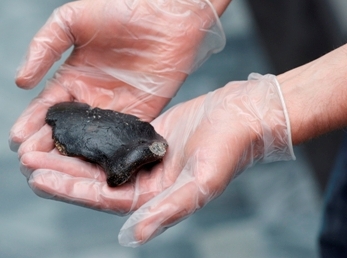 A Neanderthal skull fragment found in North Sea sediments is the oldest human bone discovered underwater, according to research announced this week.
A Neanderthal skull fragment found in North Sea sediments is the oldest human bone discovered underwater, according to research announced this week.
Geoscientist Online, 17 June 2009
The fragment, discovered 15 kilometres off the coast of the Netherlands, originates from the skull of a young adult male. It was identified by an international group of scientists, including Professor Jean-Jacques Hublin from the Max Planck Institute for Evolutionary Anthropology at Leipzig in Germany, and Professor Wil Roebroeks of Leiden University.
Fishermen and dredgers frequently find fossil remains and artefacts in the region. The latest find was buried in sediments from an extraction zone located in the Zeeland Ridges area, and identified as Neanderthal due to its similarity to the frontal bones of other specimens from the late Pleistocene; in particular its strong brow ridge. It was found among animal remains dating from the late Pleistocene (13,000-12,000 yrs ago) and artefacts associated with Neanderthals, including flakes and small hand-axes.
The now-submerged region is referred to as Doggerland. Now under the North Sea, during cold phases of the late Pleistocene when sea levels fell by as much as 100 metres, the areas was exposed, and inhabited by a wide variety of ice age mammals as well as, according to the finds, early humans.
Professor Chris Stringer, director of the Ancient Human Occupation of Britain (AHOB) project, and palaeontologist at the Natural History Museum, has particular reason to be interested in the find.
‘This is a very significant discovery because the skull fragment represents the first ancient human found below the sea’, he says. The AHOB project, a collaboration of archaeologists, palaeontologists and earth scientists, is investigating the timing and nature of the earliest human occupation of Britain.
‘For most of the last half-a-million years’ explains Professor Stringer, ‘sea levels were significantly lower than today, and at times, substantial areas of the current North Sea were dry land. There were extensive river systems with wide river valleys, lakes and floodplains, and these areas were rich habitats for large herds of herbivores and the animals that preyed on them, including early humans’.
Isotopic analysis of the specimen suggests that the diet of such early humans was dominated by meat, supporting results from previous specimens. About 60,000 years ago, Neanderthals were crossing Doggerland to reach Britain, where their artefacts are associated with mammoth fossils at Lynford, a site in Norfolk. The find could be significant for those involved in the heated debates surrounding the earliest occupation of Europe and Britain.
Despite the specimen being the first of its kind, fossil discoveries from the North Sea are not as unlikely as they might sound.
‘The North Sea is one of the world’s richest areas for mammal fossils because of its relatively shallow southern region, much of which is less than 50 metres deep’, says Professor Stringer.
Human remains, however, are scarce, although he is hopeful for more such finds in the future.
‘Woolly mammoth, woolly rhinoceros, horse, reindeer and other Pleistocene mammal fossils are brought ashore every year by the fishing industry and other dredging operations, and some fishermen now concentrate on collecting fossils rather than fish. Who knows what else we may find’.
- Out of the North Sea: the Zeeland Ridges Neanderthal is published in the Journal of Human Evolution